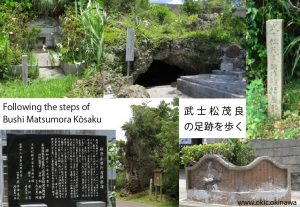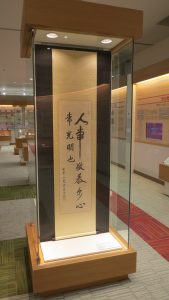Special feature articles
-
2023.09.19
Karate Today - Yoshizato Hiroshi's Birth!
-
2023.08.29
Karate Today - Honolulu Karate Youth Club Found...
-
2023.08.15
Karate Today - Nakandakari’s Birth!
-
2023.08.03
Karate Today - Noma Seiji made his wedding in O...
-
2023.07.18
Karate Today - Yabu Kentsu conducts Karate prom...
-
2023.07.04
Karate Today - First "Karate Club" created for ...
-
2023.06.20
Karate Today - Yoshimura Chogi visited the form...
-
2023.06.06
Karate Today - Karate club at Prefectural First...
-
2023.05.26
Karate Today series will begin
-
2021.12.20
Martial arts demonstration in front of the king...
-
2021.03.08
Folktale: Why tigers can't climb trees
-
2020.12.22
About Rei – Part 2 by Nakamoto Masahiro
-
2020.11.17
Okinawa Karate "WA" Series
-
2020.10.05
About Rei – Part 1: Mabuni Kenei
-
2020.06.19
1969 article on master Yagi and Sūpārinpe
-
2020.05.22
1969 article on master Higa and Passai Dai
-
2020.05.08
1969 article on master Shimabukuro and Ānankū
-
2020.04.20
1969 article on master Kushi and Wankan
-
2020.04.14
1969 article on masters Kaneshima and Nagamine
-
2020.04.09
Article ”Even at 80 years old “Eyaa!” ” (Okinaw...
-
2020.04.09
Article ”Impressed with every move” (Ryūkyū Shi...
-
2019.12.03
Kobudō 9: Nakaima Kenkō and Uchima Anyū
-
2019.11.07
Kobudō 8: Kyan Shinei and Kaneshima Shinei
-
2019.10.29
Kobudō 7: Ishikawa Hōei and Higa Seitoku
-
2019.10.08
Kobudō 6: Nohara Kamaichi and Takara Shigeru
-
2019.09.13
About the estimated new photo of Itosu Ankō
-
2019.09.02
Karate policemen protecting the safety and secu...
-
2019.07.02
Kobudō 5: Soken Hōhan and Shiroma Taisei
-
2019.06.08
Kobudō 4: Kameshima Shinsuke and Chinen Masami
-
2019.06.01
Kobudō 3: Nakamura Shigeru and Higa Yūsuke
-
2019.05.24
Kobudō 2: Irei Matsutarō and Nakamura Heisaburō
-
2019.05.14
Kobudō 1: Kina Shōsei and Shinjō Heisaburō
-
2019.04.08
Questioning the weapons’ hunt
-
2019.01.21
Kyō Ahagon Jikki, the sword and karate
-
2018.05.04
The unveiling of the statue of Uechi Kanbun
-
2017.12.26
Following the steps of Matsumora Kōsaku
-
2017.10.20
Brushwork of late Matsumura Sōkon
-
2017.10.14
Maekawa bō performed at the Shihan Gakkō
-
2017.09.08
The declaration of the "Karate Day"
-
2017.08.15
A district connected to karate, Uebaru
-
2017.07.14
The beauty of Okinawa karate
During the Ryūkyū Kingdom, Tomari was a port city involved with the foreign trade of the Shuri court. It was the entrance for foreign visitors and the culture they brought. Along the way, the area became the birthplace of many experts in the fields of Chinese classics, performing arts, music, martial arts among others.
It is said that Tomari’s temple Seigenji, commonly known as Ameku’s temple, was the base of activities of foreigners who disembarked in Tomari port. Among these were drifted ashore Chinese and Korean merchants. Tomari people were instructed in martial arts by these foreigners, which later gave birth to Tomarite, a martial art differing from the martial arts of Shuri and Naha.
Tomarite is said to have started with Teruya Kishin (1804-1864) and Uku Karyū (1800-1850). The one who inherited their art was Matsumora Kōsaku (1829-1898). He is considered as the one who rejuvenated Tomarite.
Today, there are at least 6 sites in the Okinawa prefecture that are landmarks in regard to the Tomari master’s legacy.
The most famous is indeed the praising monument located in the Shinyashiki Park. Raised in May 1983, it is located between Route 58 and the Tomari international cemetery.
Close-by, near the Tomari temple of Seigenji is the Kāmi-nu-yā cave where Matsumora Kōsaku is said to have train with a man who lived there.
A passage about this cave can be found in the 1970 published book "Karate (Tomarite) Chukō no So, Matsumora Kōsaku Ryakuden" (1) by Matsumura Kōshō. Previously named Matsumora, the author is the grandchild of Matsumora Kōsaku.
It is said that after receiving instruction in karate from Uku Karyū and Teruya Kishin, “Kōsaku went to ask for karate instruction to a Chinese who lived in a cave called ‘Kāmi-nu-yā’ on the shore of Tomari (although according to another version, it was a Ryūkyū man who hid from the royal government and thus dressed as a Chinese; anyway, the truth is unknown). At first, his request was refused but due to Kōsaku’s ardent desire, he received instruction…”
The third monument in Naha is located close by the Tomari elementary school and is known as the Bushi Matsumora relief sculpture.
Next to these three monuments and sites, there are 3 other sites that relates to the master.
One of them is the Fērē rock in Onna Village where Matsumora subdued some bandits.
A second one mentioned on the monument raised in Shinyashiki Park and in Matsumura’s book is the master’s retreat in northern Okinawa. Finally, Matsumora’s tomb is located in Onna Village.
Mainly remembered as a martial expert, Matsumora Kōsaku actually personifies a true Okinawan Bushi, meaning that next to having acquired great martial skills, he also contributed to the society. An example of his contribution is inscribed on the monument as follow.
“In the past in Tomari Village, in addition to community property received from the Ryūkyū royal administration, existed a common property called ‘Nēwagumuchi’. It was donated for the welfare of Tomari villagers by Yamazato Chōken, who passed the royal government examination and became a government official (2).
When came the abolition of feudal domains and establishment of Okinawa Prefecture in 1879, Japanese government officials planned a policy to pull up this fortune. However, at the risk of his life, the bujin of Tomari Matsumora Kōsaku demonstrated his strong spirit and the project was abandoned. Today still, the donation is utilized as funding for the Tomari Senkaku Kenshōkai, the Tomari Pioneers Praising Association. We hand to posterity the name of the fist saint Matsumora, a man who persisted in the path of crushing evil and spreading the true.”
(1) The title could be translated as “Short biography of the rejuvenator of Tomarite Karate, Matsumora Kōsaku”.
(2) Born in a poor family, Yamazato Chōken (1820-1893) raised to become a royal clerk. It is said that after passing the royal examination, he gave a huge sum of money to Tomari that was to be used for the education of local nobles.
Sources: Karatedō and kobudō preliminary survey report, Okinawa Prefecture Board of Education, Matsumura Kōkatsu’ s "Bushi Matsumora Kōsaku Ryakuden" (published in 1970)
In the Archives of the Okinawa Karate Kaikan is exhibited a brushwork once calligraphed by late Matsumura Sōkon, the great karate master.
The sentence composed of 10 characters was once introduced in Miyagi Tokumasa’s book “Karate No Rekishi” published in 1987 by Okinawa Bunko. The piece exhibited in the Archives is a replica of the original.
It seems that this phrase was taken from the “Zhuzi yulei”, a collection of conversations relating to neo-Confucian scholar Zhu Xi.
In his book, Miyagi Tokumasa wrote “Bushi Matsumura is known as a Bujin who also excelled in Bunbu Ryōdō, scholarship and the martial arts. The brushwork hereby appearing is a good and suitable material to prove this fact. The phrase reads as ‘Hito, tsuneni keikyō nareba, sunawachi kokoro wa tsuneni kōmyō nari’ (1). It was written by Sōkon when he was 76 years old of age. From the strength of the brush work and the phrases, it is indeed the artwork of a Bujin.”
In this splendid calligraphy by Matsumura Sōkon who adopted the calligrapher name “Unyū” and was also called “Buchō” the head of martial arts, the second character on the right from top reading “常 - Tsune” or always is particularly beautifully written. The viewer can easily imagine a revolving sai, the trident of kobudō or an ornamental hairpin called jīfā in Okinawa.
Do not miss to visit the Okinawa Karate Kaikan to admire the calligraphy of Matsumura Sōkon, a man who is considered as one of the “Chūkō no so (2)” of karate.
(1) One translation could be: If one is always respectful, that is the heart will always be bright.
(2) Chūkō no so: There are 3 masters considered as the rejuvenators of karate: Matsumura Sōkon (Shurite), Matsumora Kōsaku (Tomarite) and Higaonna Kanryō (Nahate).
Photo credit: Okinawa Prefecture Karate Promotion Division – Okinawa Karate Kaikan
From 1925 until 1927, His Highness Prince Chichibu studied in England. On his way to Europe, he stopped in Okinawa in May 1925. On this occasion, a karate demonstration was organized for him at the Okinawa Shihan Gakkō, the Okinawa Normal School. The leader of the karate demonstration was Miyagi Chōjun, who would later established Gōjū-ryū.
While this demonstration is widely known as a karate event, there is another side to it that proves that karate and bōjutsu - staff martial art are inseparable.
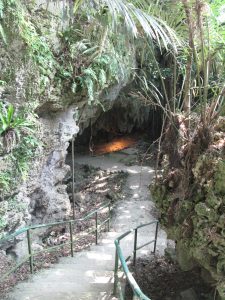
Located in Maekawa, Tamagusuku, Nanjō City, Okinawa World is one of the major cultural theme parks of Okinawa. Also known as Gyokusendō for the marvelous limestone cave located inside the park, Okinawa World also managed the Valley of Gangala situated opposite to the main park. Inside the premises can be found the Bugeidō (above photo), a martial art cave that relates to the local staff, Maekawa-bō.
According to a staff member, before WWII and the battle of Okinawa, bōjutsu was performed during local festivals and one of the performing groups used to train inside the Bugeidō. Indeed, there is a large space inside the cave that would allow martial practice.
It is common knowledge that in the past, martial experts trained secretly. In the Maekawa Village Annals, it is written, “At the occasion of village celebrations and the likes, people would rehearse their performances. The sense of rivalry between each group was fierce. After dark, people would gather in the house of their respective group’s chief or in caves to train late at night, away from other parties’ eyes.”
Furthermore, like in many other districts of Okinawa, bōjutsu was popular in the Maekawa district. In the annals previously mentioned, a chapter is dedicated to a particular bōjutsu demonstration. It reads as follow.
“On May 12th, 1925, while His Highness Prince Chichibu stopped by Okinawa on the way to Europe, Oshiro Jūrō (Naka ufugushiku gwa), chairman of the Maeda Youth Association, a group once awarded by the Okinawa Prefecture, was asked to perform in front of his highness during a Kobujutsu demonstration as a representative of Tamagusuku Village. The notice from the prefecture was addressed to the ward chief, Oshiro Gensaku.
On the date, in the school grounds, a Kobujutsu demonstration with representatives of each municipalities of the prefecture was held. Students of the normal school performed karate and kumite. The Maekawa Youth Association representing Tamagusuku Village performed the kata “Sūji nu kun (Shū shi no kon)” and received a huge ovation from the floor. All travel expenses and uniforms were provided by the Okinawa Prefecture.
Furthermore, at the same period, a person from Shuri by the name of Bō Ufugusuku was appointed as a bōjustu instructor by the Okinawa Prefecture and dispatched to the Maekawa ward. It is said that for 14 days, visiting Maekawa daily, he taught diligently bōjutsu Sūji nu kun from PM2:00 till PM5:00 for 3 hours, on the square of the ward office.”
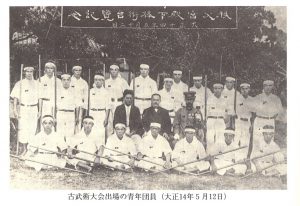
(The above photo is the youth association members who participated in the Kobujutsu demonstration, dated of May 12, 1925)
The valuable document that is the Maekawa records depicts the society of the time and the situation of Okinawan martial arts during the Taishō era (1912-1926). It also tells that martial arts in Okinawa comprised karate (kata?), kumite and bōjutsu.
Today, a monument stands where used to be the Okinawa Shihan Gakkō or Normal school and it is also possible to visit the training site that used to be Bugeidō.
As for the Maekawa Youth Association, it is nowadays active as a “performing arts troup”. Next to the traditional dance “Ayagu” (1), it strives to preserve “Yushiguē” (2), “Mēkata-bō” (3) and “Tinbē” (4), performances past down since ancient times in Maekawa.
Source: Tamagusuku Village Maekawa Annals, Okinawa Karate News Issue 58
Notes:
(1) Ayagu is a male dance emphasizing the importance of cooperation between people.
(2) Yushiguē is a dance depicting agriculture work with the hoe as main prop.
(3) Mēkata-bō is a martial dance performed with a staff.
(4) Here, Tinbē is a fighting dance performance using a shield and a blade weapon similar as in traditional kobudō.
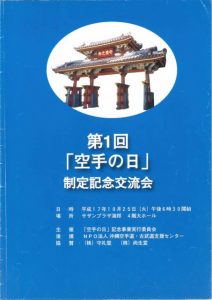
(Brochure of the 1st commemoration event held on October 25, 2005)
In 2005, the Okinawa Prefecture Assembly passed the resolution declaring October 25th Karate no hi, the day of karate. Below, we present an English translation of this important declaration.
From then, every year the Okinawa Prefecture and Okinawa karate circles have held commemorative events on this day. Last year the Guinness record for "Most people performing a kata" was also achieved.
This year's Karate Day commemorations will be held on October 25th (Wed.) at the Okinawa Karate Kaikan and on October 29th in Naha City's Kokusai Street.
Resolution on the declaration of the day of Karate
(translated by Okinawa Karate Information Center)
Some 700 years ago, karate was born in this land, Okinawa. Coexisting with the beautiful nature and climate of Okinawa, our predecessors created karate, a traditional culture that Okinawa can be proud of. It was originally called "tī".
Meanwhile, our ancestors who were called "People bridging nations" actively interacted with people from China and Southeast Asia and other different countries throughout the world. Thus, they raised peace and prosperity by bringing the culture and wealth of the world to this land.
Along with these exchanges, Chinese martial arts were introduced between 1400 and 1500. Karate, which until then had been evolving on its own way, enthusiastically adopted the strong points of Chinese martial arts and bloomed spectacularly. This is the karate that is being passed down to present days.
On October 25, 1936, the name "Karate (open hand)" which is familiar to world karate enthusiasts and many people over the world was officially decided. Therefore, it is meaningful to preserve this day as a "special day" in history.
As it is well known, the world's karate population is estimated to be around 50 million people. Karate is said to go beyond borders, language, religion, regime and race barriers, and popular in 150 countries. In just half a century after the war, karate has spread intensively to all corners of the world. From this, it is undeniable that karate has an incredible charm and splendor.
Needless to say, there is no other Okinawan culture that has spread so widely, influenced so many people and become so familiar around the world.
Furthermore, in karate exists a foundational principle of “Martial art of Peace" that is based of the great philosophy of “Karate ni sente nashi – there is no offense in karate” and the respect of life ideology found in “Nuchi du takara – Life is a Treasure". This principle is something today's international community is highly looking for and we believe that we can contribute in this sense.
Therefore, praying for the future development of Okinawa traditional karate while wishing to contribute furthermore to world peace and the happiness of the humanity, we, this prefectural assembly, declare “October 25” to be “Karate no hi - the Day of Karate”.
We pass the resolution as mentioned above.
March 29, 2005
The Okinawa Prefecture Assembly
Note: You are free to use this translation but please mention its origin.
Shuri, Naha and Tomari are districts regarded as the original cradle of karate. Yet, many other regions in Okinawa have their own martial art tales. Among these districts is Uebaru in Naha City.
Uebaru is located in between the Monorail Akamine Station and the Kaigungo Navy Headquarters Park, situated not far from the Okinawa Karate Kaikan. The area is famous for Shicha nu utaki (1) about which is written as follows.
“This area is nicknamed Machigā. In Oroku, this is where reconstruction started after the war. Many people came to live here. Right next to it can be found Machigā no Utaki. In the book ‘Ryūkyū Koku Yurai Ki’ (2), the name of the village Matsugawa (pronounced Machigā) is mentioned but no Utaki by the name of Matsugawa appears. However, looking in the list of Den (3), Machigā no Utaki is mentioned. In this case, it seems that the residence of the Matsugawa hamlet’s lord and the utaki became one.
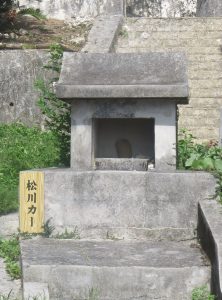 (Machigā)
(Machigā)
In some cases, a lord’s residence means only a ‘nā’ or garden, a place where festivals are held. Since there is an utaki there, sacred palm family plants called Māni have been planted in the area. This manifests the holy aspect of the site.
A long time ago in Uebaru, there were a lot of bushi. These bushi practiced karate every evening in this area. Bushi of Okinawa are different from bushi of Mainland Japan as here it means men with mighty physical strength.”
According to a deceased venerable man, “In Uebaru there existed an undulating slope called Nana kēn biragwā (4). A long time ago, Uebaru gave birth to a great amount of martial art experts, and along the way that became an issue. Therefore, the said slope was improved. After the land amelioration, no more bushi were born in Uebaru”.(5)
The site where the bushi trained is now a public park by the name of Takamaehara Park.
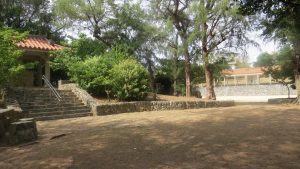 (Shicha nu utaki)
(Shicha nu utaki)
On the Sunday that follows the lunar calendar June 25th (6), the Uebaru tug of war is held. In 2017, this Sunday falls on August 20th. While many tugs of war in Okinawa are soul-stirring and brawl-like events, the tug of war of Uebaru is a simple and elegant one. It is a festival to express gratitude for the rice plant harvest.
Tours in the district can be organized by local residents. If interested, please contact the Okinawa Karate Information Center.
Footnotes:
- Utaki means a sacred site or grove. In that case, the name could be translated by "lower sacred site".
- It is said that the first Ryūkyū Kingdom official records were compiled in early 1700.
- Den most likely refers to Dunchi, or nobles or lords’ residences.
- Kēn most likely refers to the measure unit for 1,8 m. Therefore, Nana kēn may mean 12,6 m.
- Although there is no explanation in the text, having such a slope in the area might mean that locals had the opportunity to train their legs and hips by running which is essential in karate training.
- Roku gatsu kashichī or June kashichī is a rice plant harvest festival, a traditional event held according to the lunar calendar. Held on June 25th, rice cooked with fresh rice is presented as offerings to the hi-nu-kan, the god of fire and the family altar.
* The address of the park is 2-5 Takara, Naha City
Sources:
Work field on the history of Oroku (Naha City Oroku south public hall, 1993)
Naha Folk tale document (Naha City Board of Education, 1984)
